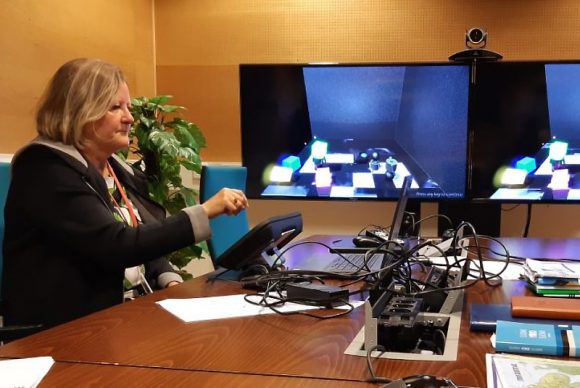By Juha Orre, Lapland University of Applied Sciences
The Northern parts of the World Heritage Struve Geodetic Arc project had one significant investment in equipment in the beginning. Lapland University of Applied Sciences bought one Ultrahaptic device and will develop some innovative application with it during the following year. Ultrahaptics technology allows users to receive haptic feedback without the need for wearable or portable devices. In other words: don’t touch, just wave your hands to control the view, which is actually more than welcome in public spaces during these globally challenging times. Haptic refers to a technique that utilizes the sense of touch. The device uses ultrasound to reflect sensations in the air and directly into the user’s hands.
No separate VR controllers are required and the device works on standard computers, the connection is made with a standard USB c cable. Users can feel touchless buttons, get feedback on gestures in the air, or interact with virtual objects. Virtual reality can be viewed on a computer screen or using VR glasses.

Closeup of Raija Lummi testing ultrahaptic device.
The technology is currently being studied, and next year the ideation of using it in the Struve project will begin. The starting point is to think about what kind of virtual reality the project might need, and how and where the device could be used, in addition to the exhibition taking place around the Northern parts of the World Heritage Struve Geodetic Arc in spring 2022. The idea is also influenced by the target group of users, whether the development work is aimed at a certain age group or whether users are generally thought of. For programming, a development platform will be built. That appears to be a Unity or Unreal environment. The technology also needs the Ultraleap Tracking SDK produced by Leap Motion.
However, programming is only a part of the creation of the virtual world. An example of the use could be a virtual journey along the Struve Geodetic Arc. The dream could be to model the whole meridian arc with all its measurement points, and at each point you could view the landscapes as a 360⁰ view. The views could store information such as measurement, local culture and nature. 3D modeling, of course, requires graphic artists, the device only controls the views and moves from one point to another.
So, the above is a dream. The actual work begins with the study of single-point modeling. For example, Alatornio church can be chosen as the first destination, as it’s 3D model is in progress, and 360⁰ imaging has also been performed. 360⁰ imaging have already been performed from several other places as well and more pictures will be produced next year, and these images will be viewed with virtual glasses at the Tornio Valley Museum. One topic of research is also whether the above and the Ultrahaptic Platform can be integrated with each other.
Other uses are also being considered. For example, an idea competition could be organized among the students, fresh views are always welcome. The location of the device is also under consideration, it should be easily and free of charge available to the public. It can, however, be tested in the exhibition which the project will organize in spring 2022. In this way, awareness of the Struve Geodetic Arc, the culture and nature along it would grow among people. Undoubtedly, the new technology would also attract people who would not otherwise move in nature or learn about World Heritage, and perhaps make them climb the hill to look at the scenery.




